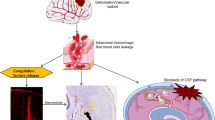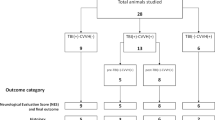Summary
Several experimental brain oedema models are currently available, but most of them are very different from what happens in clinical practice. As it is simple and seems to replicate the range of injuries seen in man we decided to evaluate Marmarou's model of head injury in order to test physiopathogenic and therapeutic hypotheses.
Three groups of Wistar rats weighing 360–400 gr, anaesthetized with sodium pentobarbitone and breathing spontaneously, without tracheal intubation, were studied. In the first group six animals were killed two hours after injury and the brain's water content compared with that of nine controls. In another group Evans blue (100 mg/kg) was injected one hour before trauma and dye's extraction ratio determined at various times after injury: five animals at 15 minutes, six at 30 minutes, five at 60 minutes and nine at 120 minutes. A total of twenty-eight animals served as controls. In the last group morphological studies with light and electron microscopy were performed in the traumatized brain tissue from rats killed 5 and 120 minutes after injury and in brain tissue from control rats.
Results showed that Marmarou's brain trauma model induced perivascular brain oedema, already visible at the ultrastructural level 5 minutes after the injury. Endothelial cells themselves were “oedematiated”, rich in pinocytotic vesicles and membrane blebs, and presented intact tight junctions. Two hours after trauma the perivascular oedema was more marked. At this time the brain water content was significantly higher than that in controls. Evans blue extraction ratio increased linearly with time, being significantly higher than in controls 120 minutes after injury.
We conclude that Marmarou's model is a suitable model for the study of brain oedema induced by trauma, and that this oedema, assessed by three different methodologies, was statistically significant two hours after injury.
Similar content being viewed by others
Author information
Authors and Affiliations
Rights and permissions
About this article
Cite this article
Vaz, R., Sarmento, A., Borges, N. et al. Experimental Traumatic Cerebral Contusion: Morphological Study of Brain Microvessels and Characterization of the Oedema. Acta Neurochir (Wien) 140, 76–81 (1998). https://doi.org/10.1007/s007010050061
Issue Date:
DOI: https://doi.org/10.1007/s007010050061




